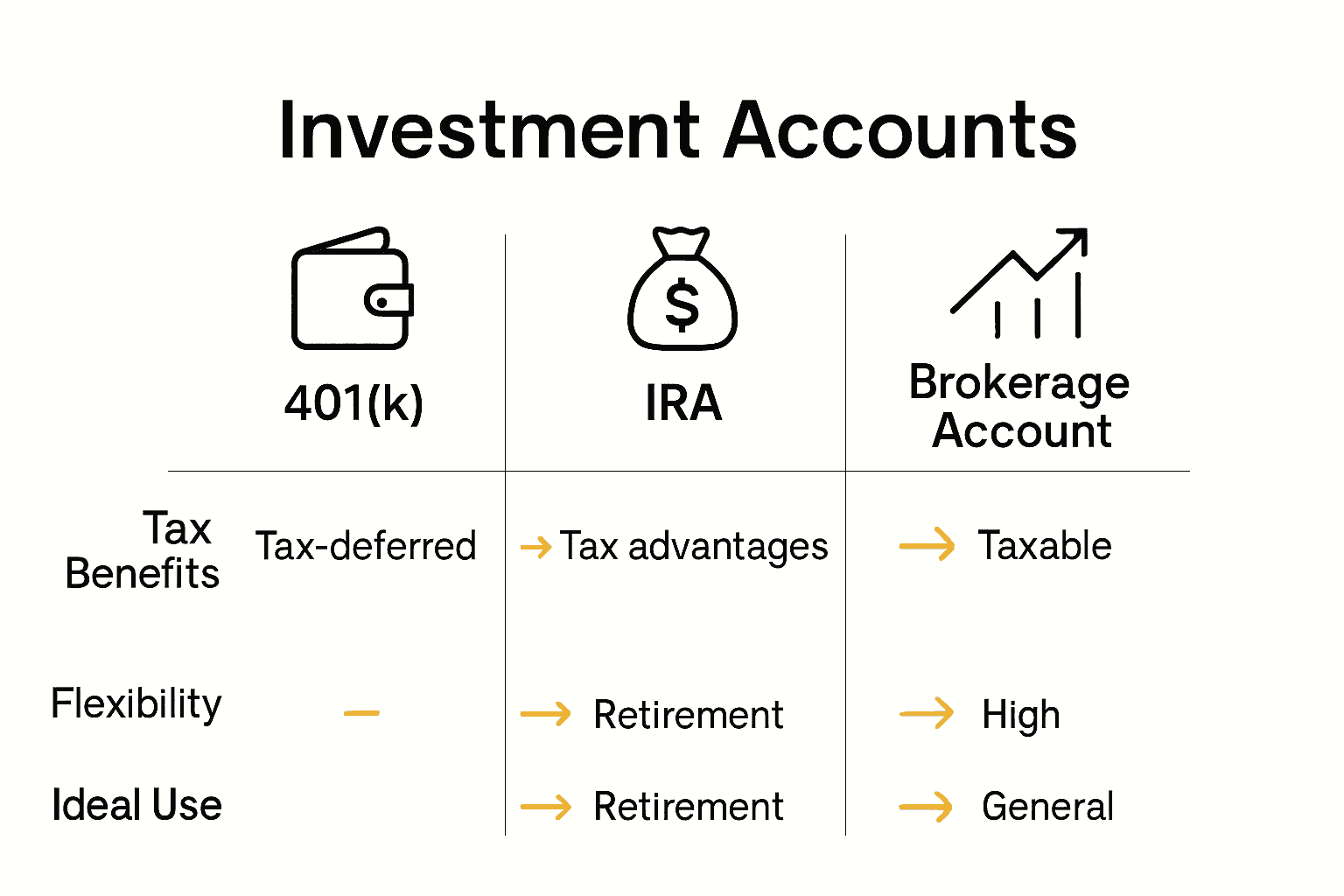Most new investors skip a critical first step that can shape their entire financial future. Over 60 percent of people start investing without a clear understanding of their own finances. Knowing exactly where you stand financially is the backbone of every successful investment plan. The right approach helps you avoid costly mistakes, set realistic goals, and pick strategies that fit your life. Whether you are just starting out or looking to refine your methods, it all begins with an honest look at your financial health.
Table of Contents
- Step 1: Assess Your Financial Situation
- Step 2: Set Clear Investment Goals
- Step 3: Select the Right Investment Accounts
- Step 4: Choose Suitable Investment Options
- Step 5: Monitor Performance And Make Adjustments
Quick Summary
| Key Point | Explanation |
|---|---|
| 1. Assess your financial health | Understand your assets and liabilities to determine your net worth, establishing a clear financial baseline. |
| 2. Set SMART investment goals | Define specific, measurable, achievable, relevant, and time-bound goals to guide your investment strategies effectively. |
| 3. Choose appropriate investment accounts | Select accounts that align with your financial goals, prioritizing tax-efficient options for long-term investing. |
| 4. Diversify your investment options | Explore various investment categories such as stocks, bonds, and funds to spread risk and enhance returns. |
| 5. Regularly monitor and adjust your portfolio | Routinely review your investments and make adjustments based on performance and life changes to stay on track. |
Step 1: Assess Your Financial Situation
Before jumping into investing, you need a clear snapshot of your current financial health. This crucial first step will help you understand exactly where you stand and determine how much you can realistically invest. According to University of Georgia, the foundation of smart investing begins with examining your assets and liabilities to calculate your net worth.
Start by creating a comprehensive financial inventory. List out all your current assets such as savings accounts, checking balances, retirement accounts, real estate equity, and any valuable possessions. On the opposite side, document all your liabilities including credit card debt, student loans, mortgage balances, car loans, and any other outstanding financial obligations. Subtract your total liabilities from your total assets to determine your current net worth. This number provides a clear baseline for understanding your financial starting point.
Most financial experts recommend establishing an emergency fund before making significant investments. Aim to save 3 to 6 months of living expenses in a readily accessible savings account. This safety net will protect you from unexpected financial challenges and provide peace of mind as you begin your investment journey. Setting Smart Financial Goals can help you create a structured approach to building this emergency reserve and preparing for future financial success.
Step 2: Set Clear Investment Goals
Setting clear investment goals is your roadmap to financial success. This critical step transforms your investing journey from a random walk to a strategic expedition. According to Washington State Department of Financial Institutions, determining specific investment objectives helps guide your selection of appropriate investment strategies and financial products.
Start by identifying your short term and long term financial objectives. Short term goals might include saving for a down payment on a home, building an emergency fund, or planning an upcoming major purchase. Long term goals typically involve retirement planning, funding your children education, or creating generational wealth. For each goal, define three key elements your timeline, target amount needed, and your risk tolerance.
 Consider how soon you need the money and how much volatility you can emotionally and financially withstand.
Consider how soon you need the money and how much volatility you can emotionally and financially withstand.
To make your goals actionable, use the SMART framework specific to investing. This means creating Specific, Measurable, Achievable, Relevant, and Time bound goals. For instance, instead of saying “I want to save for retirement,” a SMART goal would be “I will invest $500 monthly in a diversified retirement portfolio to accumulate $750000 by age 55.” What is a Financial Plan can provide additional insights into creating comprehensive financial strategies that align with your investment objectives.
Step 3: Select the Right Investment Accounts
Choosing the right investment accounts is crucial for maximizing your financial potential and aligning your investments with your specific goals. According to the Securities and Exchange Commission, evaluating your financial roadmap and understanding different investment accounts will help you make informed decisions that support your long term financial objectives.
Start by exploring the most common investment account types. Retirement accounts like 401k and Individual Retirement Accounts (IRA) offer significant tax advantages for long term savings. Taxable brokerage accounts provide more flexibility for short term and intermediate goals. Each account type comes with unique benefits such as potential tax deductions, employer matching contributions, or greater investment freedom.
 Consider your current financial situation, tax bracket, and investment timeline when selecting accounts. For young investors, a Roth IRA can be particularly attractive because it allows tax free withdrawals during retirement.
Consider your current financial situation, tax bracket, and investment timeline when selecting accounts. For young investors, a Roth IRA can be particularly attractive because it allows tax free withdrawals during retirement.
To make a strategic selection, match your investment accounts to your specific financial goals.
If youre saving for retirement, prioritize tax advantaged retirement accounts. For shorter term objectives like purchasing a home or building an emergency fund, a standard brokerage account might make more sense. 7 Safe Investment Options can provide additional insights into choosing investments that complement your selected account types and align with your risk tolerance.
Step 4: Choose Suitable Investment Options
Selecting the right investment options is a critical step that can make or break your financial future. According to Investor.gov, thoroughly researching investments is essential to ensure they align with your unique financial goals and personal risk tolerance. This means moving beyond surface level recommendations and diving deep into understanding each potential investment.
Start by exploring diverse investment categories that match your financial objectives. Stocks offer potential for high growth but come with higher volatility. Bonds provide more stability and consistent income. Mutual funds and exchange traded funds (ETFs) allow you to diversify your investments across multiple securities with a single purchase. Consider your risk appetite carefully. Young investors with longer time horizons can typically tolerate more risk, while those closer to retirement might prefer more conservative options. The Securities and Exchange Commission recommends ensuring any investment thoroughly aligns with your financial goals before committing your hard earned money.
To make informed decisions, leverage resources that help you understand different investment options. Master Building an Investment Portfolio can provide additional insights into constructing a balanced investment strategy. Remember that diversification is key your goal is to spread risk across different types of investments so that a downturn in one area doesnt devastate your entire portfolio. Start small, continue learning, and gradually build your investment knowledge and confidence.
Step 5: Monitor Performance and Make Adjustments
Successful investing is not a set it and forget it process. According to the Washington State Department of Financial Institutions, regularly monitoring your investments and making strategic adjustments is crucial to staying on track with your financial objectives. Think of your investment portfolio like a garden that requires consistent care and occasional pruning to remain healthy and productive.
Establish a consistent review schedule to assess your investment performance. Aim to review your portfolio quarterly or semi annually, but avoid making impulsive changes based on short term market fluctuations. During these reviews, compare your investments performance against benchmark indexes and your original financial goals. Pay attention to asset allocation and ensure your investments remain balanced. If certain sectors or assets have significantly shifted, you might need to rebalance by selling overperforming investments and reinvesting in underrepresented areas to maintain your desired risk level.
Remember that life changes can necessitate investment strategy adjustments. Major personal events like marriage, having children, changing careers, or approaching retirement might require you to recalibrate your investment approach. Understanding Short Term Investment Options can help you adapt your strategy as your financial landscape evolves. The key is remaining flexible while staying committed to your long term financial vision. Dont be afraid to consult with a financial advisor if you feel uncertain about making significant portfolio modifications.
Take Control of Your Investment Journey Today
Starting your investing journey can feel overwhelming. This guide highlights the challenges you might face like assessing your financial situation, setting clear goals, choosing the right accounts, and picking suitable investments. You want to avoid costly mistakes and build confidence while creating a plan tailored to your risk tolerance and timeline. Understanding concepts like SMART goals and diversification is essential but not always easy alone.
You do not have to navigate these steps by yourself. At finblog.com, we specialize in helping new and experienced investors like you make informed decisions. Whether you need guidance on setting SMART financial goals or want to learn more about safe investment options our expert insights are designed to turn confusion into clarity. Don’t wait for uncertainty to hold you back. Visit finblog.com now and take the next step toward securing your financial future.
Frequently Asked Questions
What should I assess in my financial situation before starting to invest?
Before investing, assess your financial situation by creating a comprehensive list of your assets and liabilities to calculate your net worth. Start by listing savings, retirement accounts, and any debts, then subtract liabilities from assets to establish your financial baseline.
How do I set clear investment goals?
To set clear investment goals, identify both your short-term and long-term financial objectives, such as saving for a home or retirement. Use the SMART framework to define Specific, Measurable, Achievable, Relevant, and Time-bound goals, making them actionable for your investment planning.
What types of investment accounts should I consider?
Consider different types of investment accounts, such as retirement accounts (like a 401k or IRA) for long-term savings and taxable brokerage accounts for more flexibility. Match your investment account choices to your specific financial goals, prioritizing tax-advantaged options for retirement savings.
How do I choose suitable investment options?
To choose suitable investment options, explore categories like stocks, bonds, mutual funds, and ETFs that align with your financial objectives and risk tolerance. Start by investing in a diversified mix, gradually building knowledge and confidence as you learn about each option.
How often should I monitor my investment performance?
Aim to monitor your investment performance quarterly or semi-annually to stay aligned with your financial goals. During these reviews, assess your portfolio against benchmarks and rebalance if necessary to maintain your desired risk level and asset allocation.
When should I adjust my investment strategy?
Adjust your investment strategy whenever significant life events occur, such as marriage or retirement, which may impact your financial landscape. Stay flexible, and don’t hesitate to consult with a financial advisor if you feel uncertain about making changes to your portfolio.










